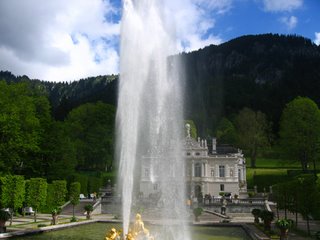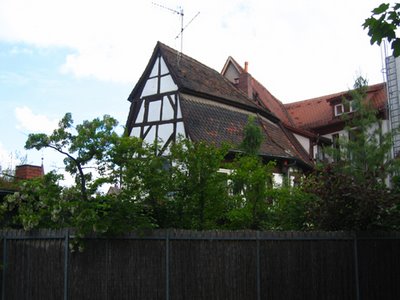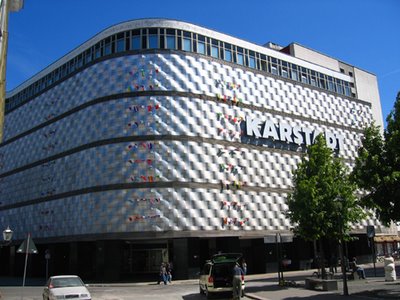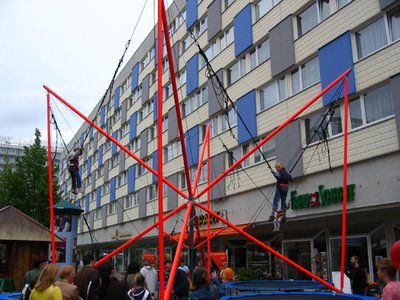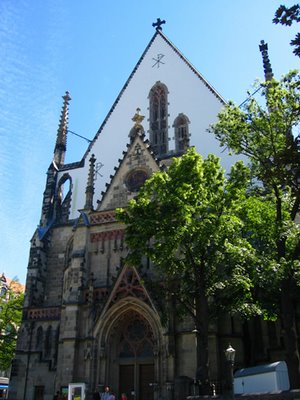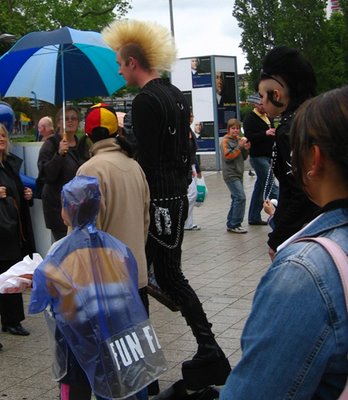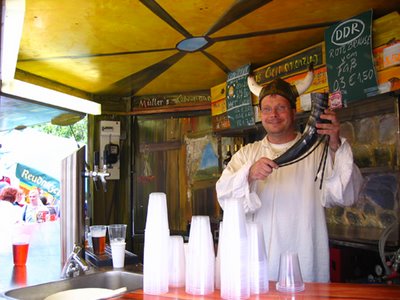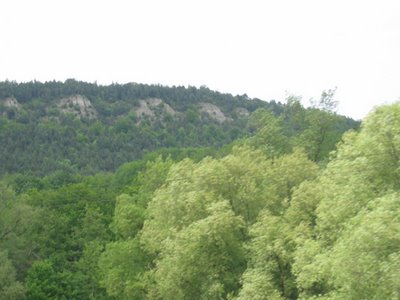Today was Leipzig’s Stadt Fest, a big town festival, drawing unusual numbers of people to the usually crowded downtown of Leipzig, one of eastern Germany’s coolest cities. It was also a festival for local lesbians, who were holding court over in the university district; and Goths, seemingly from all over the country, descended on Leipzig like crebain from Dunland. The endless parade of people in black, many of them too overweight to pull off a successful ‘Goth’ look, reminded me of what I was reading this time last year: Seattle Opera was producing the
Ring (like every tiny town in mittel Europa is right now) and there wasn’t a whole lot of prep work for me, since I’d done it before; so our Production Assisstant, the wondrous Marta Johnson, fed me, episode by episode, all of Neil Gaiman’s
Sandman epic—a disturbing, disorganized, fascinating meditation, in comic book form, on the nature of dreams and stories. “I have had a dream—past the wit of man to say what dream it was.” And the other night, as I lay in the long grass under the elder tree on the banks of the Elbe, like Anselmus, I recalled his wondrous dreaming, and Richard Wagner’s, which began in the same spot but which was in a weird way real. Or at least, he somehow made it real.
My own dream—my film project, and unfortunately there are now two of them—is to build a structure where we can compare and contrast all these competing dreams, realities, and whatever else may or may not exist.
The idea has been in my head for a long time. Let me explain in more detail. Film operates very differently than theater; when you SEE things, even things which never existed, you know and believe them in a way you never can in the theater (what with suspension of disbelief and all). The sky turned round for me, on this topic, when I was 18 and first watched Zefirelli’s weird film of
Otello. Although I’d make a different movie of this opera if I were doing it today, I was and still am blown away by the most simple and powerful trick in film—when a character is narrating something, go film it! Example: the first act ends with the awesome duet “Già nella notte densa,” in which the libretto recaps all the important stuff from the otherwise deleted Shakespeare’s Act One. Lots of stories—how Otello wooed Desdemona with stories, the content of those stories, how they fell in love. And Verdi’s music falls into the cracks between every word—the music acts out the stories and stories-within-stories for us, as it were. But onstage, in the theater, what you SEE is a tenor and soprano, usually kind of ridiculous and/or offensive looking, and maybe every now and then they’ll cup each other’s hands in that “squirrel paws” position which all opera singers seem genetically pre-determined constantly to do, and which I so abhor and revile. I’ve only ever once seen anyone do that in real life—and he’s now running for state congressman from my neighborhood.
What do we see in Zefirelli? All the stories! Including the ones they’re telling, ones in the Shakespeare first act, even stories Zefirelli obviously made up. But it’s brilliant. Not only does it give us something to look at—film is a visual medium and he’s a gorgeous filmmaker—it guves us MORE INFO about the characters and their story. A great story thoughtfully told, as I said before. Instead of distracting us with an irrelevant and annoying visual, which can sometimes happen in the theater. So—the obvious thing to do would be to film Wagner’s
Ring à la Zefirelli, showing the audience what the characters are talking about whenever the
Ring goes into one of its zillions of narrations. A nice idea, but it will never happen. There isn’t that much money in the world, and frankly, the resulting film would be unwatcheable. The
Ring ought to be experienced live, in the theater. (Methinks theater directors might look at including film techniques and technologies in their arsenal of story-telling tools...) What we can do, however, is make a film about Wagner’s life—let’s get it out by 2013, the bicentenerary of his birth—and do a few spots from his operas, filmed à la Zefirelli, with the CG technical prowess of a Peter Jackson—and use the medium to show the tremendous gulf between the world of his imagination and the world in which he lived (and tried to make his dream come to life).
Brief digression over my second film project, hitherto unmentioned—it actually fits in really well right here. I think we should make a fancy Peter Jackson & Co special effects spectacular film on E. T. A. Hoffmann’s
The Golden Pot, one of my all-time favorite stories, a story about this exact same issue, and not coincidentally one of Wagner’s favorite stories too. (Once, when no one was paying any attention to him at a party he was hosting, Wagner emitted a piercing shriek and then informed the assembled company that he was now going to read
The Golden Pot—all 100 pages of it—to them out loud. Charming man!) The story concerns the strange adventure of the young Student Anselmus (think a youngish Johnny Depp in a Tim Burton film), who we find near the top of the story, sleeping, like Bottom, like me the other night, in the long grass beneath the elder tree on the banks of Dresden’s lovely Elbe at sunset. He falls hopelessly in love with three snakes, who appear in the grass and dazzle him; eventually, he gets a job copying out arcane texts in some language and alphabet he doesn’t understand, employed by the eccentric old town archivist (who turns out to be the spirit of phosphorous and father of the three snakes); embroiled in an all-out war between a Titania and Oberon type pair), he ends up imprisoned in a glass jar; and....well, you’ll see how it ends after we make the movie!
It’s a freakishly bizarre, wildly comic, soul-lifting, hair-on-the-back-of-your-neck-ruffling-with-a-sigh beauty of a story, all about what it means to be an artist. Anselmus has this strange epiphany—he doesn’t understand what happened to him, when he meets the snakes, all he knows is that everything else that’s ever happened to him in his life is insignificant in comparison with this experience. He has taken the first step on the road to being an artist. But the road is difficult, beset by obstacles and dangers (and weird helpers like the archivist’s parrot) and the ever-present danger of falling off the road, getting bottled and thus ceasing to be an artist (becoming a bureacrat, a functionary, an unknown citizen, a mere consumer). It’s a story which has to be read to be believed, and has to be made into a film if we are to see what we’re up against.
Or—we could just make the Wagner film. Because they tell the same story, and my guess is we might have an easier time raising money for a film about Wagner, whom many more people than me find fascinating.
The idea would be something along the lines of
Topsy-Turvy, Mike Leigh’s brilliant recreation of the Victorian period and the creation of
The Mikado (beginning with the debacle of their previous show,
Ruddigore or
Princess Ida or whatever it was). This film (title suggestions, anyone?) to follow the process of creating the
Ring—a vast subject, so we’ll have to be careful to keep it to 2 hours. Example: it would be easy to do the Shaffer/Forman trick, from
Amadeus, of cutting from footage of Barbara Brynne as Mozart’s annoying mother-in-law shrieking at him to a shot of the Queen of the Night chirping. I contend that every character in the
Ring cycle has some parallel in the composer’s biography, and would be happy to talk your ear off explaining each and ever one of them. But in the end, I don’t think this would be all that interesting (although it certainly would take up a huge amount of screen time). It would vindicate Freud’s theory about all art being sublimation of neurosis—but this I’d really rather not do, because the magical thing to me is that Wagner’s neurosis caused him to create this art—which, two hundred fifty years later, speaks so beautifully and interestingly to me without my really knowing him or his neurosis. Again, to phooey with Freud, says I.
Far more interesting than the Freudian approach is discussion of one simple biographical fact: after the first performance of the complete
Ring in 1876, at the end of the first-ever
Götterdämmerung, Wagner refused to join the curtain call. He was thoroughly disgusted with the production, and according to his assistant director’s diary he sat in his dressing room fuming, cursing everyone involved in the ordeal and accusing them all of betraying him. “Next year, we’ll do everything differently,” he said, famously. Well, it never happened; after the first Ring summer he was so deeply in debt he never produced or heard it again. He only ever saw it once in his own life, his dream become reality—and he hated it. Reality, once again, had failed to live up to imagination.
I doubt this film will end there, on that endlessly depressing note; but it might be a great place to start. Then we’d go back and try to figure out how we got there; and then, conclude in some place in between dreams and reality—where life itself must exist.
Now, you Perfect Wagnerites out there reading me in blog-land are probably thinking, “Honestly, Jon...it’s been done.” (Well...not a Golden Pot film, to the best of my knowledge.) True, there have been Wagner bio-pics before now. I’ve only ever seen two: the endless Tony Palmer/Richard Burton thing from the early 80s, which I found wrong-headed and incredibly tedious; and an earlier one, one of the first feature-length German films, a silent movie about 75 minutes long filmed in the teens and starring a contemporary Italian composer who oddly resembled Wagner (the way Robert Powell looked like both Jesus and Gustav Mahler). To conclude an enormous (but crucial!) blog post, some thoughts about those films and what mine would do differently:
Silent Film. This is a wonderful document, restored and presented in Seattle recently by Paul Fryer. (The original music was lost, and I didn’t think much of the newly prepared soundtrack.) It was a hagiography from the pre-Hitler days of the Bayreuther Blätter, and as such incredibly entertaining if you know the real story and probably kind of dull if you don’t—all the outrageous behavior and self-destructive tendencies of this terribly flawed man were concealed, even though that’s precisely what an audience would find interesting. I loved this film for one particular feature, which I fully intend to steal: every time Richard Wagner sat down to write an opera, we cut to footage from a scene from that opera. He was sitting at his desk, for example, scribbling away with a sad look in his eye, and suddenly there were Wotan and Brünnhilde on the rock, tearfully saying their farewells. An old-timey, 1912 Wotan and Brünnhilde (something you can’t see anywhere today) with those absurd helmets and breastplates and all that hair. Yes—our 1912 film cut to scenes from the operas, as they looked in 1912! Which makes it a valuable historical document, although the reaction of a modern film audience will inevitably be: “Gee, they sure look goofy!”
Palmer/Burton Thing. It ended up being about 9 hours long; it didn’t make a lick of sense if you didn’t already know all about Wagner’s life; and frankly, the soundtrack was a disgrace. The great thing about the movie
Amadeus, if you ask me—actually there are any number of great things about it, the great thing that’s relevant here—is that the music was treated as seriously as the picture. They got Neville Marriner in from the start of the project, story-boarded musical sequences, recorded every piece especially for the film, and the result was a new generation (I was 10 when that first came out) fell in love with Mozart. I don’t know much about the specifics of what Palmer did to get his music; it’s always sounded to me like he got rights from Decca London to use up to 3 minutes from any one of their Solti Wagner recordings, because we keep hearing the same few moments over and over again—Mime’s misery, Tristan’s wound, Ludwig’s Lohengrin-ish frenzy. There’s a moment or two where they filmed Peter Hofmann and Gwyneth Jones as Ludwig and Malvina Schnorr von Carolsfeld, I think, but really it was shocking the disregard that movie had for musical values. This is a movie about music! You start with the music and build your way backwards from there.
A couple of other things annoyed me about the Palmer film. Occasionally there was a narrator, who spoke in the first person—although I could never figure out who he was supposed to be, and he never gave helpful narration such as “Then Wagner and his wife had to cross the Baltic Sea to escape from creditors in Riga”, for example—instead, we see a low-budget boat-in-stormy-sea shot, and, since it’s out of sequence, if you don’t already know the story you’re hosed. The cast list was strong—too many British accents, if you ask me, since most of the characters are German or Swiss—but too many characters, and not enough set-up for each one.
And I’m sorry, but I really think Burton missed the point. He had all of Wagner’s repulsive qualities, but none of his charm and charisma—which must have been considerable—and none of his mania, which everyone who knew him found remarkable. Said Robert Schumann, another of Leipzig’s greatest sons: “For me, Wagner is impossible. There’s no doubt that he’s an intelligent person, but he never stops talking. You can’t talk all the time.” I imagine someone with the energy of Robin Williams in the role—a little out of control, scary/edgy, but entertaining. And I don’t think it’s worth making the film withough the right person in the role, an actor who might come close to this one-of-a-kind personality.
Seeking Richard. (For lack of a better title, we’ll go with the name of this blog.) This film will offer three things:
a) The imagination of Richard Wagner filmed with all the Peter Jackson fancy CG stuff we can get our hands on. Imagine our end of
Götterdämmerung, visualized by Weta Workshop! Imagine the
Siegfried Act 3 scene change, as Siegfried sounds his horn and ascends up into the fire—as the horn motif wrestles with the fire motif, we see Siegfried wrestling with a cool CG Loge (maybe he’s like Johnny Fire from Fantastic Four), like Jacob and the Angel, until finally Siegfried wins—only now his flesh is scorched, he is now touched by the fire god, and has become a sun good—thus Brünnhilde salutes him, “Heil dir, Sonne”. Thus the sun rises and sets in
Götterdämmerung with his horn motif now made divine. Imagine the cameras spinning around the fjord and the ships as the Dutchman’s chorus competes with Daland’s; imagine the entry of the gods into Valhalla atop a real rainbow; imagine each of Kundry’s crazed flashbacks brought expressionistically to life. Like the Freudian find-the-art-in-the-neurosis temptation, the possibilities here boggle the mind.
b) But we’ll tame them, rein them in, by choosing ones we can then immediately juxtapose with the reality Wagner saw in his own theater; a filmed Siegfried scaring Mime with a CG bear, for example, followed by the grotesque and absurd charade you always see in the theater. And it will become very clear why he was so disappointed, at that first-ever
Götterdämmerung.
And c) the most important point of all: I promise to tell a great story thoughtfully. The human story of what it took to create the
Ring—the huge sacrifices made by Minna, Otto, Mathilde, Cosima, Hans, Ludwig, and others. What Peter Jackson showed me, in his astonishing film about that other
Ring, is that no matter how fancy your CG must be, a good story is always about PEOPLE. There are some really interesting people in the story of the
Ring’s genesis, and if we build a screenplay which forces the film to treat them as real people, we’ll have quite a tale to tell.


